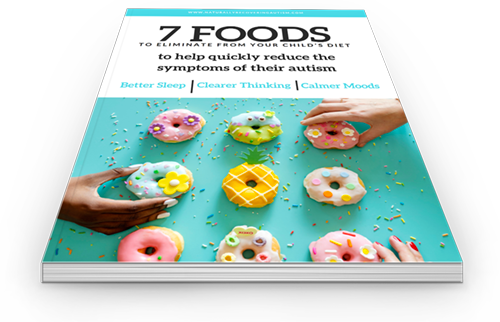Statistics show the rate of autism recovery is significantly higher with a parent’s intervention.
As a parent of a child with autism, navigating the journey can be overwhelming. From understanding the diagnosis to exploring various treatments, the path can seem unclear and daunting.
However, by taking control of your child’s biomedical path, you can make informed decisions that lead to meaningful improvements in their health and quality of life. This episode provides guidance on how to empower yourself with knowledge, create a roadmap, and take charge of your child’s biomedical journey.
Understanding Biomedical Interventions for Autism
Biomedical interventions focus on addressing the underlying biological issues that may contribute to the symptoms of autism. These interventions can include dietary changes, supplements, detoxification protocols, and addressing gut health.
The goal is to improve overall health, which can, in turn, reduce symptoms and enhance your child’s development.
Some common areas of focus in biomedical interventions include:
Dietary Changes:
Many children with autism have food sensitivities or allergies that can exacerbate symptoms. Gluten-free and casein-free diets are commonly explored, as these proteins can sometimes cause adverse reactions that are physical, emotional, and behavioral.
However, there are many additional foods that are also inflammatory and allergen triggers to be aware of. Oxalates, Salicylates, phenols, histamines, food dyes, and many others to be aware of.
My free food guide contains a list of the top 7 offenders and why they should be avoided. Get the guide at autismcheatsheet.com. Additionally, a balanced diet rich in essential nutrients supports overall well-being.
Supplements:
Certain vitamins, minerals, and fatty acids are essential for brain function and development. Parents often explore supplements like Omega-3 fatty acids, vitamin D3, and probiotics under the guidance of knowledgeable healthcare providers. Too much, too fast, will cause die off symptoms which increase behaviors as the body tries to rid itself of excess toxins.
Gut Health:
There is growing evidence and studies linking gut health to the symptoms of autism. Addressing issues like leaky gut syndrome, yeast overgrowth, and imbalances in gut bacteria can lead to improvements in behavior, communication, and overall health.
It is crucial to heal the gut. Inflammation from toxins and pathogens such as candida/fungus, parasites, Lyme, and mold biotoxins all contribute to tearing the gut lining causing leaky gut syndrome.
This allows undigested foods to leak through these holes causing further allergy responses from the immune system and increased behaviors. Leaky gut also does not allow for proper absorption of nutrients from the foods being eaten.
Detoxification:
Some children with autism may have difficulty eliminating toxins from their bodies. Detoxification protocols, such as chelation therapy, are sometimes considered to reduce the burden of heavy metals and other toxins. However, unknown to most parents, pharmaceutical drugs such as DMSA that most practitioners use for removing heavy metal toxins will allow for reabsorption of these harmful chemicals as they are trying to be excreted, and pulls out the good minerals such as magnesium and calcium.
These drugs also do not get into the cell where most heavy metals reside so your child remains toxic but they may not show up in testing. It is important to use a safe, natural method that can also reach the cell.
Steps to Take Control of Your Child’s Biomedical Path
- Educate Yourself
The first step in taking control is to educate yourself about the biomedical options available. Research reputable sources, join support groups, and attend conferences or webinars focused on biomedical interventions for autism. The more you know, the better equipped you’ll be to make informed decisions.
- Find A Guide Who Specializes in Autism
Many functional medicine doctors, naturopaths, and integrative pediatricians are often well-meaning but lack the in-depth knowledge in autism and the specifics of necessary treatments. While it’s important to be informed, working with someone who is knowledgeable and specializes in autism is crucial.
Safe, natural methods are also important, as is working with the root causes and not just symptoms.They can help guide you with recommended appropriate interventions, and help you monitor your child’s progress.
- Create a Customized Roadmap
Every child with autism is unique, and there needs to be a specific roadmap with a sequence to target issues in a specific order to help set the body up with support for best success in detoxification and pathogen fighting.
Get a customized roadmap for autism from someone who has gone before you and has a strong success record. This roadmap should outline dietary changes, natural supplementation, therapies, and other interventions you plan to implement.
Having a clear plan helps you stay organized and focused on your child’s goals. It also brings you the greatest results.
- Track Progress and Adjust Accordingly
As you implement biomedical interventions, it’s essential to track your child’s progress. Keep a journal or use an app to record changes in behavior, communication, sleep patterns, and other relevant areas.
Regularly reviewing this data with your healthcare provider allows you to make adjustments as needed, ensuring that the interventions remain effective.
- Involve Your Child in the Process
Depending on your child’s age and abilities, involve them in the process. Explain what you’re doing and why, and encourage their input where possible.
Empowering your child to take ownership of their health fosters independence and helps them understand the importance of self-care.
Education in natural health care and why a healthy diet is essential will help them to engage in these methods on their own.
- Build a Support Network
Surround yourself with a supportive community of other parents who are like-minded advocates for their child’s well-being. Sharing experiences, successes, and challenges can provide valuable insights and emotional support. Online forums, local support groups, and social media communities can be great resources.
- Be Patient and Persistent
Biomedical interventions can take time to show results, and the process may involve trial and error. Patience and persistence are key. Celebrate small victories along the way, and remember that progress, no matter how incremental, is a step in the right direction.
Common Pitfalls to Avoid
While pursuing biomedical interventions, it’s important to be aware of potential pitfalls:
Avoid Unproven Treatments: Be cautious of treatments that lack a successful track record. Stick to interventions that are supported by research and recommended by trusted autism specialists.
Don’t Overwhelm Yourself or Your Child:
Implement changes gradually to avoid overwhelming your child and yourself. A step-by-step approach allows your child’s body to adjust and helps you manage the process more effectively.
Only add in one new thing at a time, whether a supplement, or a food, and begin with the lowest possible dosages or quantity. This allows your child’s body to adjust to anything new and for you to monitor their symptoms. Don’t hesitate to slow down at the first sign of increased behaviors.
Watch Out for Information Overload:
With so much information available, it’s easy to feel overwhelmed. Focus on credible sources, find a guide who specializes in autism research, has lived it personally and has a proven track record of success. Don’t be afraid to ask for testimonials from them, so you can hear what success others may have had.
Conclusion: Taking Charge for a Better Future
Taking control of your child’s biomedical path is a powerful way to make a positive impact on their health and well-being. By educating yourself, working with an experienced guide, and having a step-by-step roadmap to follow, you can navigate this journey with more confidence and clarity.
Remember, you are your child’s strongest advocate, and your dedication to their health can lead to meaningful and lasting improvements.
Empower yourself with knowledge, be patient with the process, and know that every step you take is bringing your child closer to a brighter, healthier future.
Additional episodes for inspiration from parents I have helped navigate the autism journey:
How Diana Turned Her Son’s Autism Diagnosis Around [Podcast Episode 94]
The Importance of Consistency and A Roadmap in Navigating the Autism Journey: One Mother’s Inspirational Success Story Transforming Autism Challenges Into Triumph [Podcast Episode #182]
How One Mom’s Perseverance Brought Her Autistic Son Independence and Peace [Podcast #147]
From Non Verbal To Verbal With Autism At Age 27: One Mom’s Story of How It’s Never Too Late For Autism Recovery [Podcast Episode #123]
How Having A Mentor For Her Son’s Autism Journey Helped Shannon Reduce Overwhelm and Unlock Her Son’s True Potential [Podcast Episode #124]
What Causes the Symptoms of Autism [Podcast Episode #134]
Believing In Autism Recovery When Others Don’t [Podcast #201]
Further testimonials from Naturally Recovering Autism can be found on our website.
I am happy to help you navigate this journey and get the greatest success for your child too. See resources below to begin our journey together!
Join the Autism Recovery Action Plan for Parents of Children with Autism
Discover natural strategies to improve your child’s communication, social skills, behavior, and overall well being during this FREE 3 day action plan.
APRIL 2-4, 2025
9 AM PST | 12 PM EST
1-HOUR DAILY FOLLOWED BY LIVE Q&A
Navigating the realm of autism can be challenging. I know I’ve lived it, too. But you don’t have to do this alone. For the sum of zero dollars, you can join our community of dedicated parents who are actively shaping brighter futures for their children through this enriching 3-day experience. It is my gift to help ease your journey.
Our 3-Day Autism Recovery Action Plan serves as a guiding light on your journey, offering affordable, proven strategies and the support of a caring community.
This is for informational purposes only and is not meant to diagnose or treat. Every child’s level of recovery is different. No two people are the same. It is never implied that all children will have the same outcome. Results are all based on individual biology and the work that is done. This process takes time and various steps, effort and resources need to be weighed. Our programs are intended to help you become more knowledgeable and guide you to help bring your child a better quality of life, whatever that may be. We want to help by giving great content, direction and strategies that move you forward. Nothing on this page or any of our websites is a promise or guarantee of results or future outcomes. The results on this page and any of our websites are not typical or promised. In fact, there will be people who purchase this and other programs and never put the work into implementing the strategies taught and therefore will achieve little to no results. Our more detailed earnings disclaimer, privacy policy, and terms and conditions for this program and website can be accessed via the links below. We hold ourselves (and you) to a high standard of integrity. We are cheering you on every step of the way.












